Groundwater Aquifer Suitability for Irrigation Purposes Using Multi-Criteria Decision Approach in Salah Al-Din Governorate/Iraq
Abstract
1. Introduction
2. Materials and Methods
2.1. Study Area
2.2. Dataset
2.2.1. Vertical Electrical Sounding (VES)
2.2.2. Climate Data
2.2.3. Groundwater Wells Data
2.3. Data Interpolation
2.4. Agricultural Water Quality
2.4.1. Salinity Hazard
2.4.2. Power of Hydrogen (pH)
2.4.3. Sodium Hazard
2.4.4. Magnesium Adsorption Ratio (MAR)
2.4.5. Kelly’s Ratio (KR)
2.5. Climate Factor
Precipitation Factor by Lang (Kf)
2.6. GIS-Based Multi-Criteria Decision Analysis
- Wi = Weight of factor f
- Xi = criterion score of factor f
- Cj = constraint i.
3. Results and Discussion
3.1. Weighted Overlay Analysis
3.2. Reclassifying Datasets
3.3. Suitability Map
4. Conclusions
Author Contributions
Funding
Conflicts of Interest
References
- Alwan, I.A.; Karim, H.H.; Aziz, N.A. Investigate the optimum agricultural crops production seasons in Salah Al-Din Governorate utilizing climate remote sensing data and Agro-climatic zoning. Iraqi J. Sci. 2019. accepted. [Google Scholar]
- Food and Agriculture Organization of the United Nations (FAO). Iraq—Agriculture Sector Note: Country Highlights; Report No. 4; Investment Centre Division 2012: Rome, Italy, 2011. [Google Scholar]
- Iraq Energy Institute. Towards Sustainable Water Resources Management in Iraq; Iraq Energy Institute: Erbil, Iraq, 2018. [Google Scholar]
- Zektser, I.S.; Everett, L. Groundwater Resources of the World: And Their Use; IhP Series on Groundwater. No. 6; Unesco: Paris, France, 2004. [Google Scholar]
- Cosgrove, W.J.; Loucks, D.P. Water management: Current and future challenges and research directions. Water Resour. Res. 2015, 51, 4823–4839. [Google Scholar] [CrossRef]
- Mohamed, S.; Ibrahim, S.; Sulaiman, W.; Latif, P. Groundwater resources assessment using integrated geophysical techniques in the southwestern region of Peninsular Malaysia. Arab. J. Geosci. 2013, 6, 4129–4144. [Google Scholar] [CrossRef]
- Karim, H.H.; Schanz, T.; Ibrahim, A.N. Integration between surface geoelectrical and geotechnical datasets in Salah Al-Din area, Central Iraq. Eng. Tech. J. 2013, 31, 237–261. [Google Scholar]
- Chowdhury, A.; Jha, M.K.; Chowdary, V.M.; Mal, B.C. Integrated remote sensing and GIS-based approach for assessing groundwater potential in West Medinipur district, West Bengal, India. Int. J. Remote Sens. 2009, 30, 231–250. [Google Scholar] [CrossRef]
- Chan, F.; Kumar, N.; Tiwar, M.; Lau, H.; Choy, K. Global supplier selection: A fuzzy-AHP approach. Int. J. Prod. Res. 2008, 46, 3825–3857. [Google Scholar] [CrossRef]
- Convertino, M.; Baker, K.; Vogel, J.; Lu, C.; Suedel, B.; Linkov, I. Multi-criteria decision analysis to select metrics for design and monitoring of sustainable ecosystem restorations. Ecol. Indic. 2013, 26, 76–86. [Google Scholar] [CrossRef]
- Mileu, N.; Queirós, M. Integrating Risk Assessment into Spatial Planning: RiskOTe Decision Support System. ISPRS Int. J. Geo Inf. 2018, 7, 184. [Google Scholar] [CrossRef]
- Wang, Y.; Hong, H.; Chen, W.; Li, S.; Pamučar, D.; Gigović, L.; Drobnjak, S.; Tien Bui, D.; Duan, H. A Hybrid GIS Multi-Criteria Decision-Making Method for Flood Susceptibility Mapping at Shangyou, China. Remote Sens. 2019, 11, 62. [Google Scholar] [CrossRef]
- Gigović, L.; Pamučar, D.; Bajić, Z.; Drobnjak, S. Application of GIS-Interval Rough AHP Methodology for Flood Hazard Mapping in Urban Areas. Water 2017, 9, 360. [Google Scholar] [CrossRef]
- Jeong, J.S.; García-Moruno, L.; Hernández-Blanco, J. A site planning approach for rural buildings into a landscape using a spatial multi-criteria decision analysis methodology. Land Use Policy 2013, 32, 108–118. [Google Scholar] [CrossRef]
- Gühnemann, A.; Laird, J.; Pearman, A. Combining cost-benefit and multi-criteria analysis to prioritise a national road infrastructure programme. Transp. Policy 2012, 23, 15–24. [Google Scholar] [CrossRef]
- Gigović, L.; Pamučar, D.; Lukić, D.; Marković, S. GIS-Fuzzy DEMATEL MCDA model for the evaluation of the sites for ecotourism development: A case study of “Dunavski ključ” region, Serbia. Land Use Policy 2016, 58, 348–365. [Google Scholar] [CrossRef]
- Gigović, L.; Pamučar, D.; Božanić, D.; Ljubojević, S. Application of the GIS-DANP-MABAC multi-criteria model for selecting the location of wind farms: A case study of Vojvodina, Serbia. Renew. Energy 2017, 103, 501–521. [Google Scholar] [CrossRef]
- Abudeif, A.M.; Abdel Moneim, A.A.; Farrag, A.F. Multicriteria decision analysis based on analytic hierarchy process in GIS environment for siting nuclear power plant in Egypt. Ann. Nucl. Energy 2015, 75, 682–692. [Google Scholar] [CrossRef]
- Ebuka, A.O.; Aziz, N.A.; Abdulrazzaq, Z.T.; Etuk, S.E. Integrated Geophysical Data and GIS Technique to Forecast the Potential Groundwater Locations in Part of South Eastern Nigeria. Iraqi J. Sci. 2019, 60, 1013–1022. [Google Scholar]
- Gigović, L.; Pamučar, D.; Bajić, Z.; Milićević, M. The Combination of Expert Judgment and GIS-MAIRCA Analysis for the Selection of Sites for Ammunition Depots. Sustainability 2016, 8, 372. [Google Scholar] [CrossRef]
- Chowdhury, A.; Madan, K.J.; Chowdary, V.M.; Mal, B.C. Selection of artificial recharge zones in West Midnapur district of West Bengal, India, A GIS approach. In Proceedings of the International Conference on Groundwater Dynamics and Global Change, Jaipur, India, 19–22 March 2008. [Google Scholar]
- Jha, M.; Chowdary, V.M.; Chowdhury, A. Groundwater assessment in Salboni Block, West Bengal (India) using remote sensing, geographical information system and multi-criteria decision analysis techniques. Hydrogeol. J. 2010, 18, 1713–1728. [Google Scholar] [CrossRef]
- Adiat, K.; Nawawi, M.; Abdullah, K. Application of Multi-Criteria Decision Analysis to geoelectric and geologic parameters for spatial prediction of groundwater resources potential and aquifer evaluation. Pure Appl. Geophys. 2013, 170, 453. [Google Scholar] [CrossRef]
- Mogaji, K.A.; Lim, S.H. Groundwater potentiality mapping using geoelectrical-based aquifer hydraulic parameters: A GIS-based multi-criteria decision analysis modeling approach. Terr. Atmos. Ocean. Sci. 2017, 28, 479–500. [Google Scholar] [CrossRef]
- Aziz, N.A.; Hasan, R.H.; Abdulrazzaq, Z.T. Optimum site selection for groundwater wells using integration between GIS and hydrogeophysical data. Eng. Technol. J. 2018, 36, 596–602. [Google Scholar] [CrossRef]
- Jassim, S.Z.; Goff, J. Geology of Iraq; Dolin, Prague and Moravian Museum: Brno, The Czech Republic, 2006; p. 341. [Google Scholar]
- Al-Minshid, F.H. Groundwater Study at Al-Dibaii Area by Used Electrical Resistivity Survey and Wells Pumping Test Data. Master’s Thesis, University of Baghdad, Baghdad, Iraq, 2001. [Google Scholar]
- Al-Shehmany, H.K. Using the Shlumberger Array for Hydrogeological Investigation between Baiji and Tikrit-Iraq. Master’s Thesis, College of Science, University of Baghdad, Baghdad, Iraq, 2001. [Google Scholar]
- Al-Ibrahimi, A. The Use of Resistivity and Well Logging Methods to Study Tikrit Basin. Master’s Thesis, College of science, University of Baghdad, Baghdad, Iraq, 2009. [Google Scholar]
- Abdulrazzaq, Z.T. Application of Vertical Electrical Sounding to Delineate and Evaluate of Aquifers Characteristics in Baiji-Tikrit Basin. Master’s Thesis, College of Science, University of Tikrit, Tikrit, Iraq, 2011. [Google Scholar]
- Alwan, I.A.; Karim, H.H.; Aziz, N.A. Agro-Climatic Zones (ACZ) Using Climate Satellite Data in Iraq Republic. IOP Conf. Ser. Mater. Sci. Eng. 2019. [Google Scholar] [CrossRef]
- Abdulrazzaq, Z.T.; Aziz, N.A.; Mohammed, A.A. Flood modelling using satellite-based precipitation estimates and digital elevation model in eastern Iraq. Int. J. Adv. Geosci. 2018, 6, 72–77. [Google Scholar] [CrossRef]
- Matheron, G. Principles of geostatistics. Econ. Geol. 1963, 58, 1246–1266. [Google Scholar] [CrossRef]
- Isaaks, E.; Srivastava, R. An Introduction to Applied Geostatistics; Oxford University Press Inc.: New York, NY, USA, 1989; p. 561. [Google Scholar]
- Muhamad, M.Z.; Othman, F. Selection of variogram model for spatial rainfall mapping using Analytical Hierarchy Procedure (AHP). Sci. Iran. 2017, 24, 28–39. [Google Scholar] [CrossRef][Green Version]
- Rostami, N.; HabibiB, V.; Moghadam, R.K. Comparing deterministic and geostatistical methods in spatial distribution study of soil physical and chemical properties in arid rangelands (case study: Masileh Plain, Qom, Iran). J. Rangel. Sci. 2015, 5, 181–191. [Google Scholar]
- Ramzan, S.; Wani, M.A.; Bhat, M.A. Assessment of spatial variability of soil fertility parameters using geospatial techniques in temperate Himalayas. Int. J. Geosci. 2017, 8, 1251–1263. [Google Scholar] [CrossRef]
- Mahdian, M.H.; Rahimi Bandarabady, S.; Sokouti, R.; Norouzi Banis, Y. Appraisal of the geostatistical methods to estimate monthly and annual temperature. J. Appl. Sci. 2009, 9, 128–134. [Google Scholar] [CrossRef]
- Yang, F.-g.; Cao, S.-y.; Liu, X.-n.; Yang, K.-j. Design of groundwater level monitoring network with ordinary Kriging. J. Hydrodyn. B 2008, 20, 339–346. [Google Scholar] [CrossRef]
- Thornde, W.; Petersohn, B. Irrigated Soils, 2nd ed.; The Blakiston Company: New York, NY, USA, 1954. [Google Scholar]
- Kovda, V.A. Irrigation, Drainage and Salinity; Hutchinson Co.: London, UK, 1973. [Google Scholar]
- WHO (World Health Organization). Guidelines for Drinking Water Quality, 3rd ed.; WHO: Geneva, Switzerland, 2006. [Google Scholar]
- Richards, L.A. Diagnosis and Improvement of Saline and Alkali Soils; United States Department of Agriculture: Washington, DC, USA, 1954; Volume 60, p. 160.
- Wilcox, L.V. Classification and Use of Irrigation Water; Circular No. 969; USDA: Washington, DC, USA, 1955.
- Szabolcs, I.; Darab, C. The Influence of irrigation water of high sodium carbonate content of soils. In Proceedings of the 8th International Congress of ISSS, Trans, Hungary, 1964; Volume 2, pp. 803–812. [Google Scholar]
- Kelly, W.P. Adsorbed Sodium, cation exchange capacity and percentage sodium adsorption in alkali soils. Science 1957, 84, 473–477. [Google Scholar]
- Gregor, M. Surface-and Groundwater Quality Changes in Periods of Water Scarcity; Springer Science & Business Media: Bratislava, Slovakia, 2013. [Google Scholar]
- Khalil, M.H.; Ahmed, K.S.; Elnahry, A.E.H.; Hasan, A.N. Integrated Geophysical, Remote Sensing and GIS Studies for Groundwater Assessment, Abu Zenima Area, West Sinai, Egypt. Int. J. Geosci. 2014, 5, 882–907. [Google Scholar] [CrossRef][Green Version]
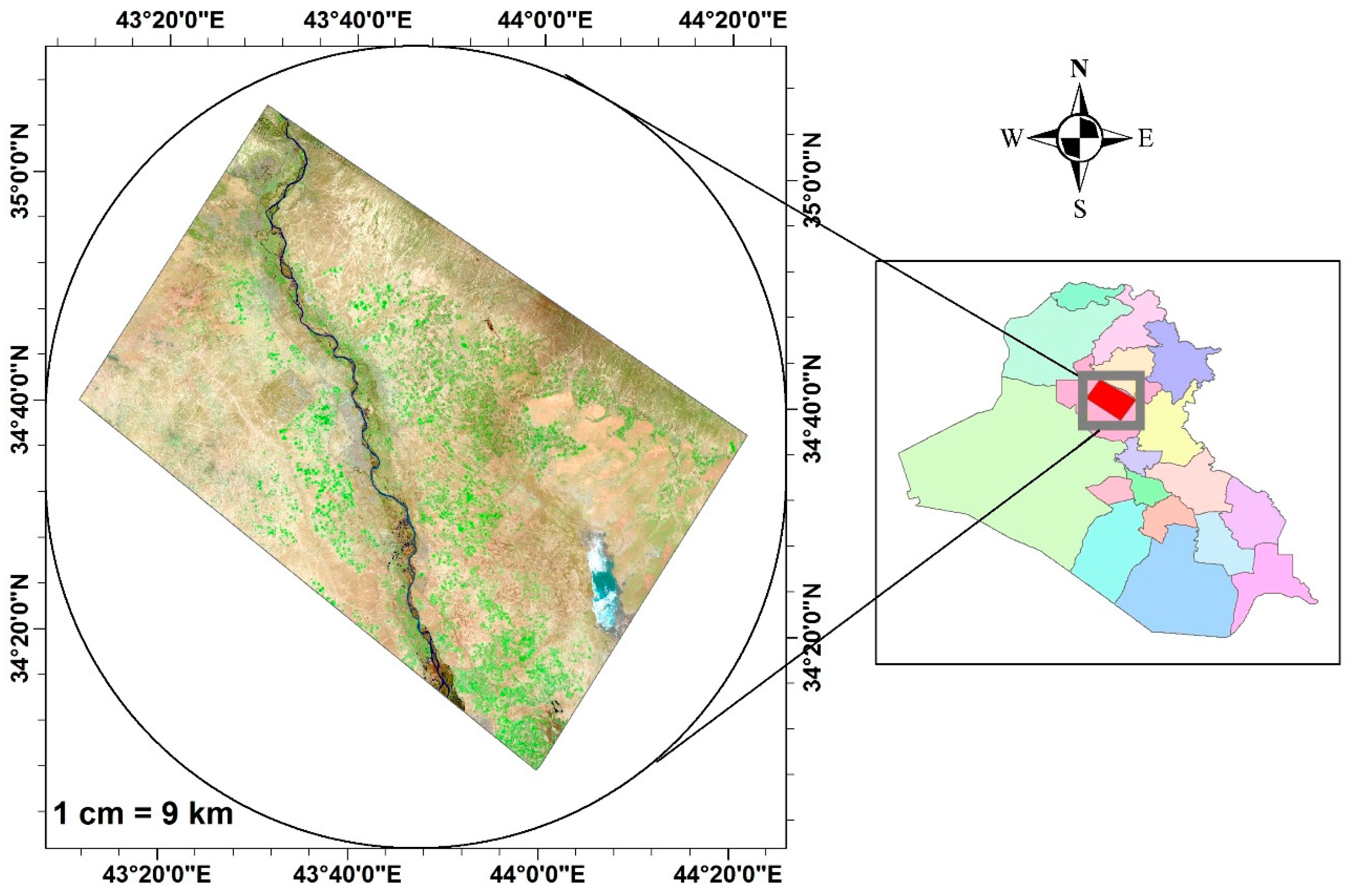
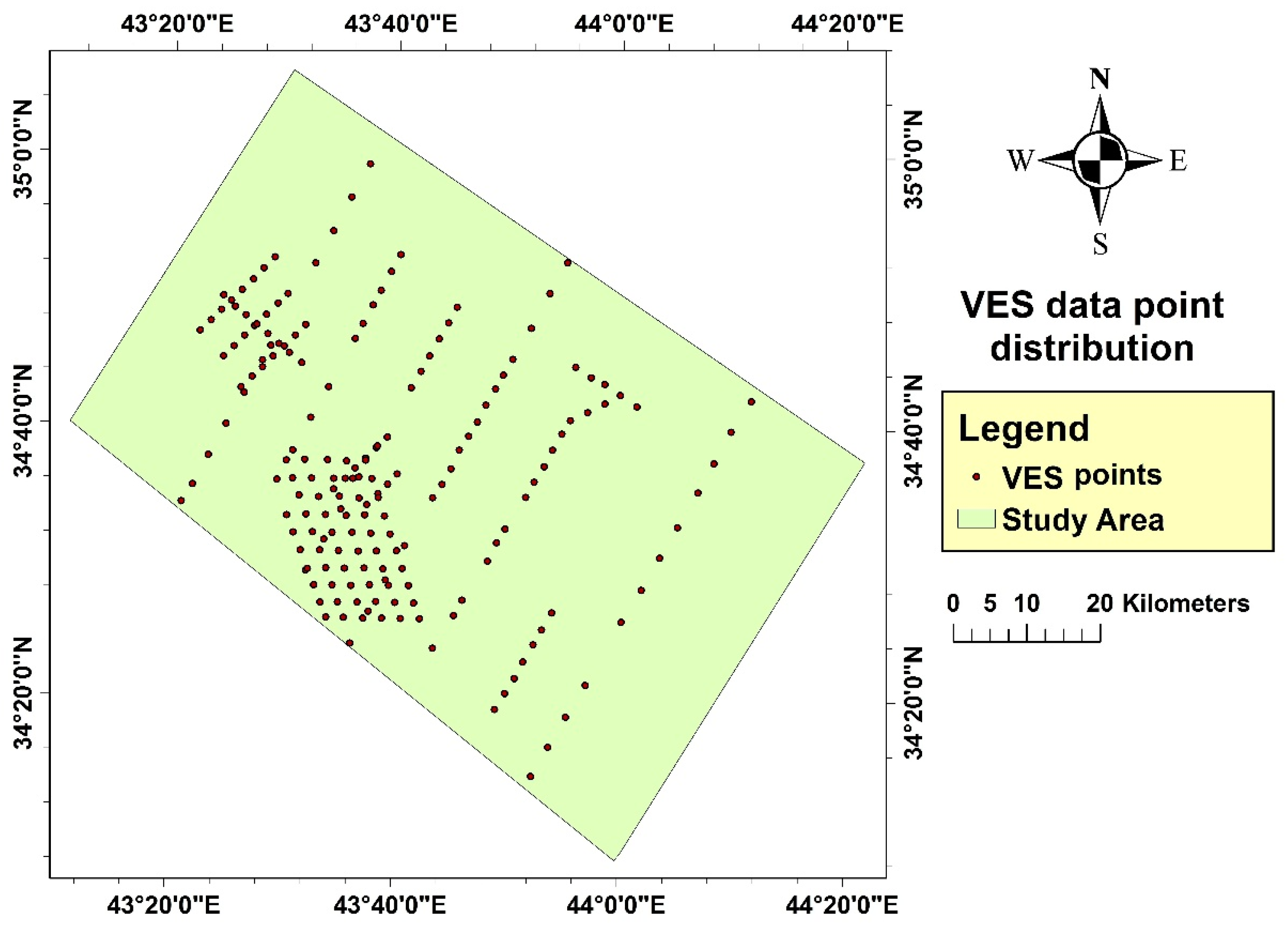
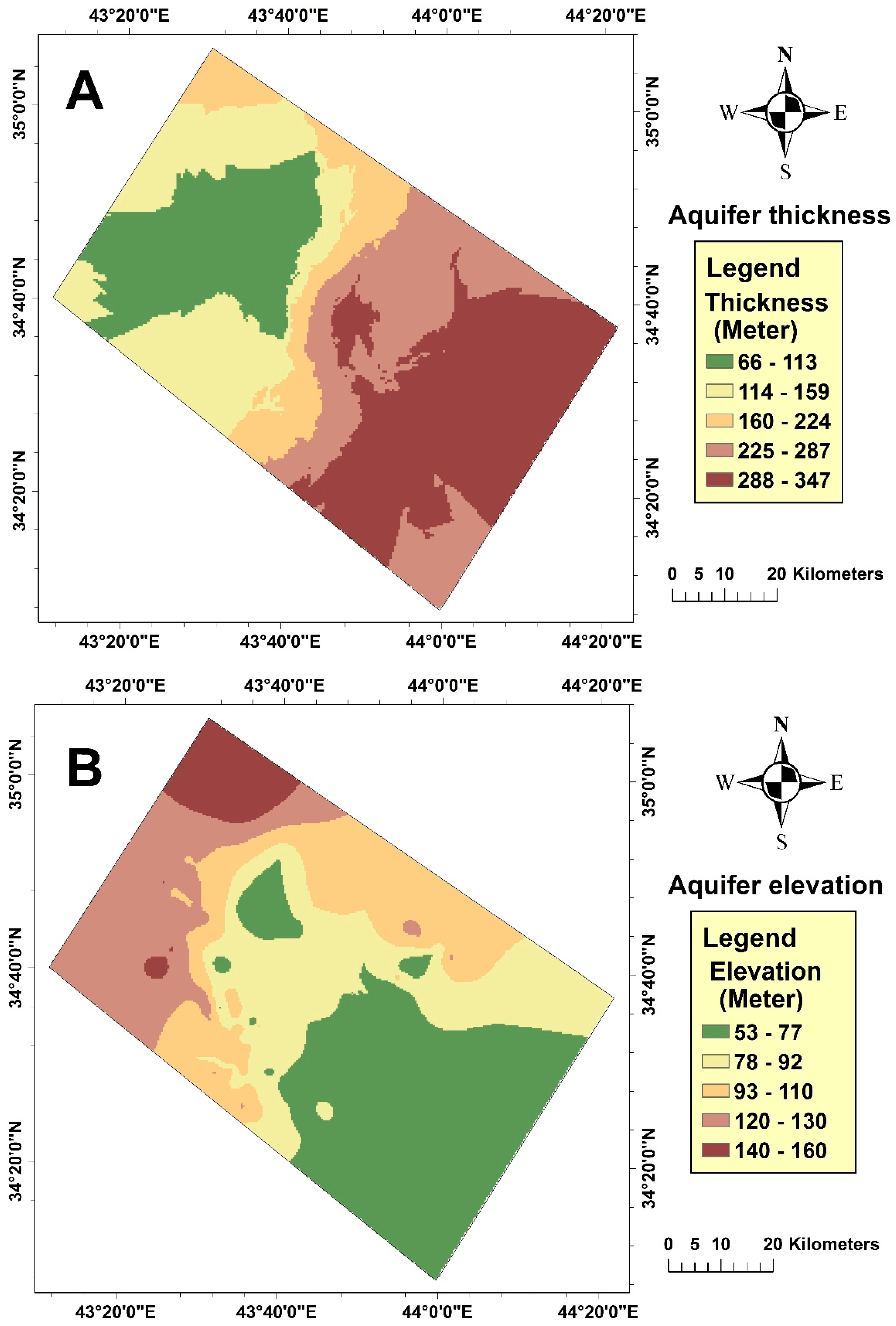
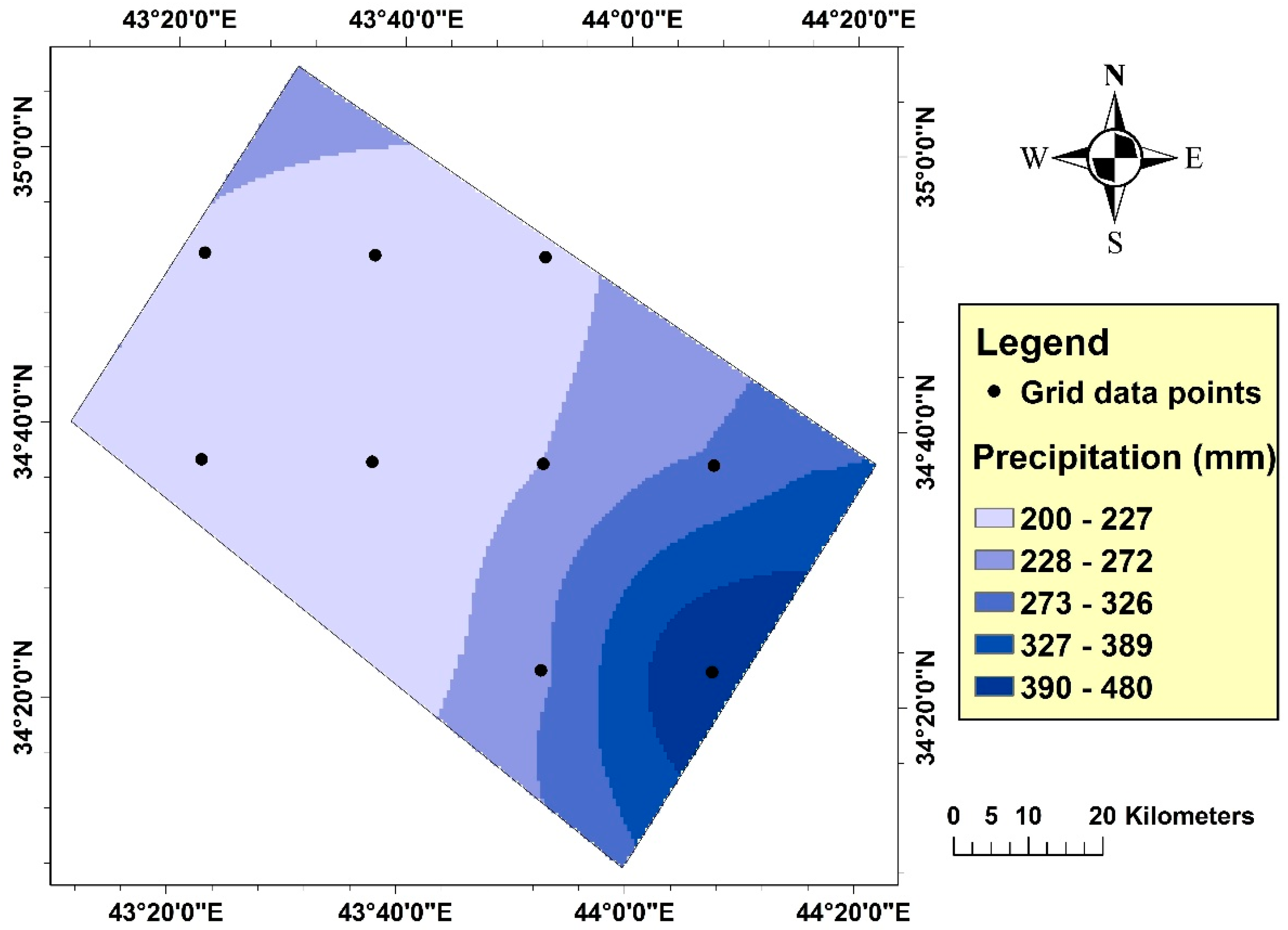
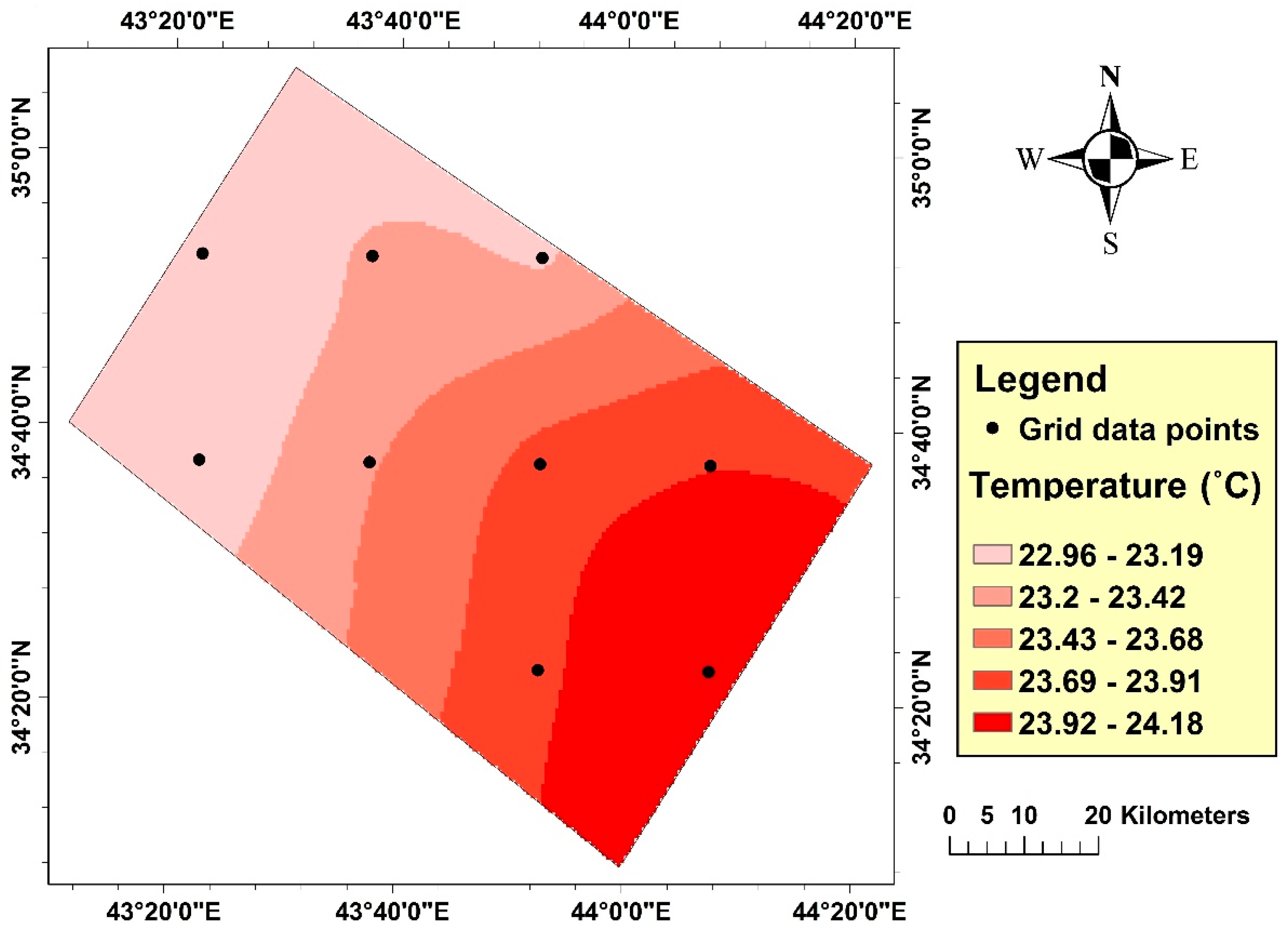
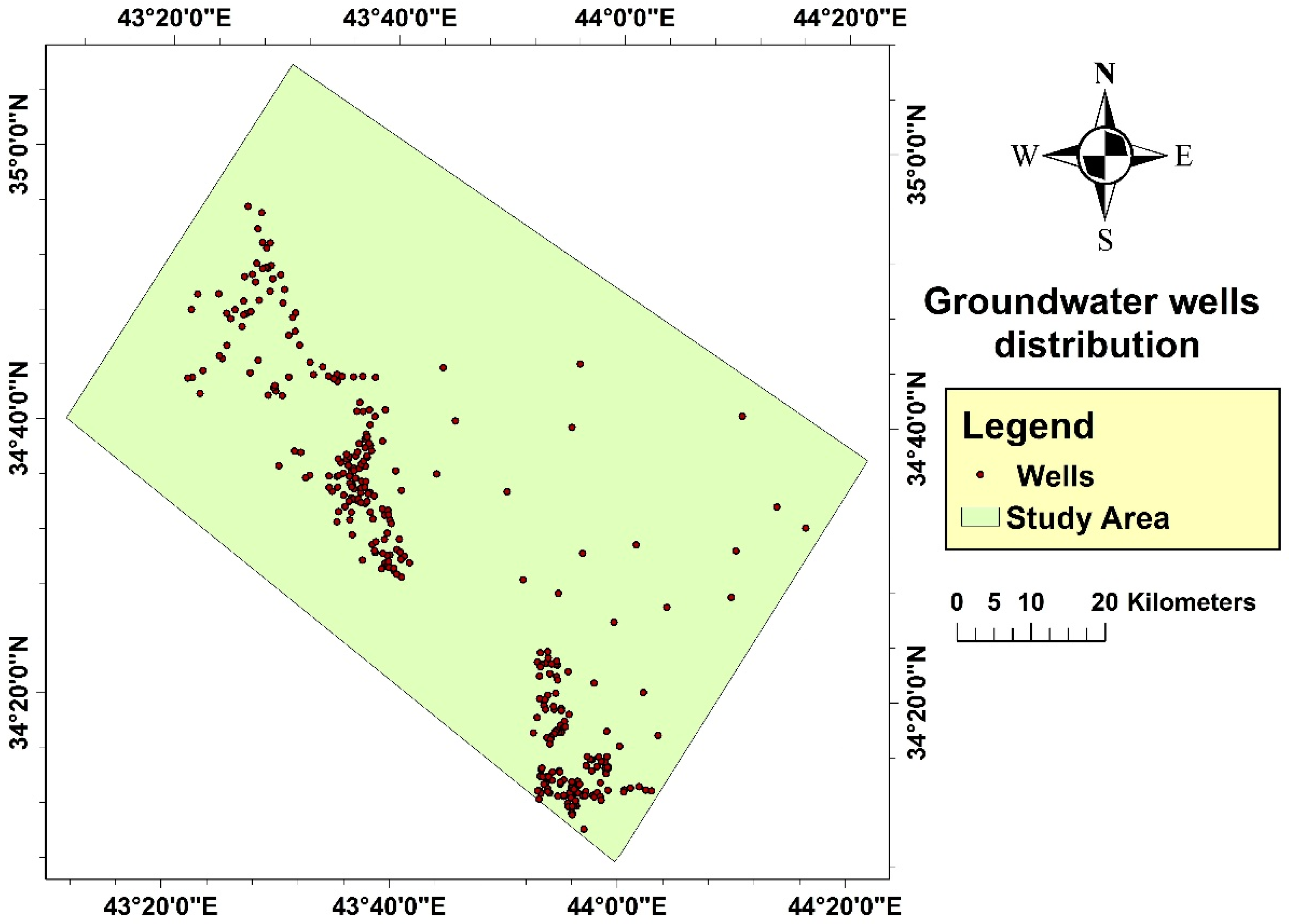
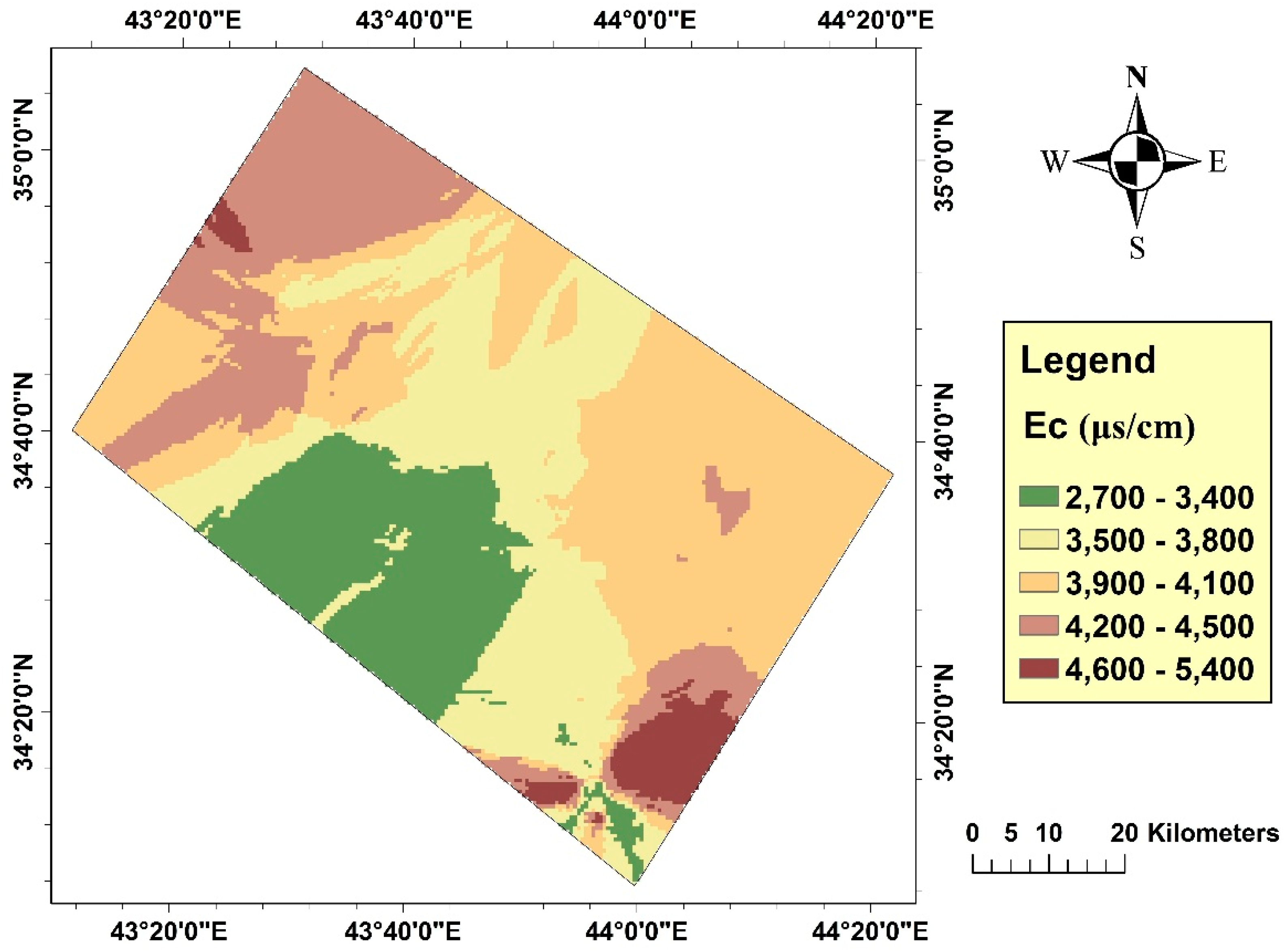
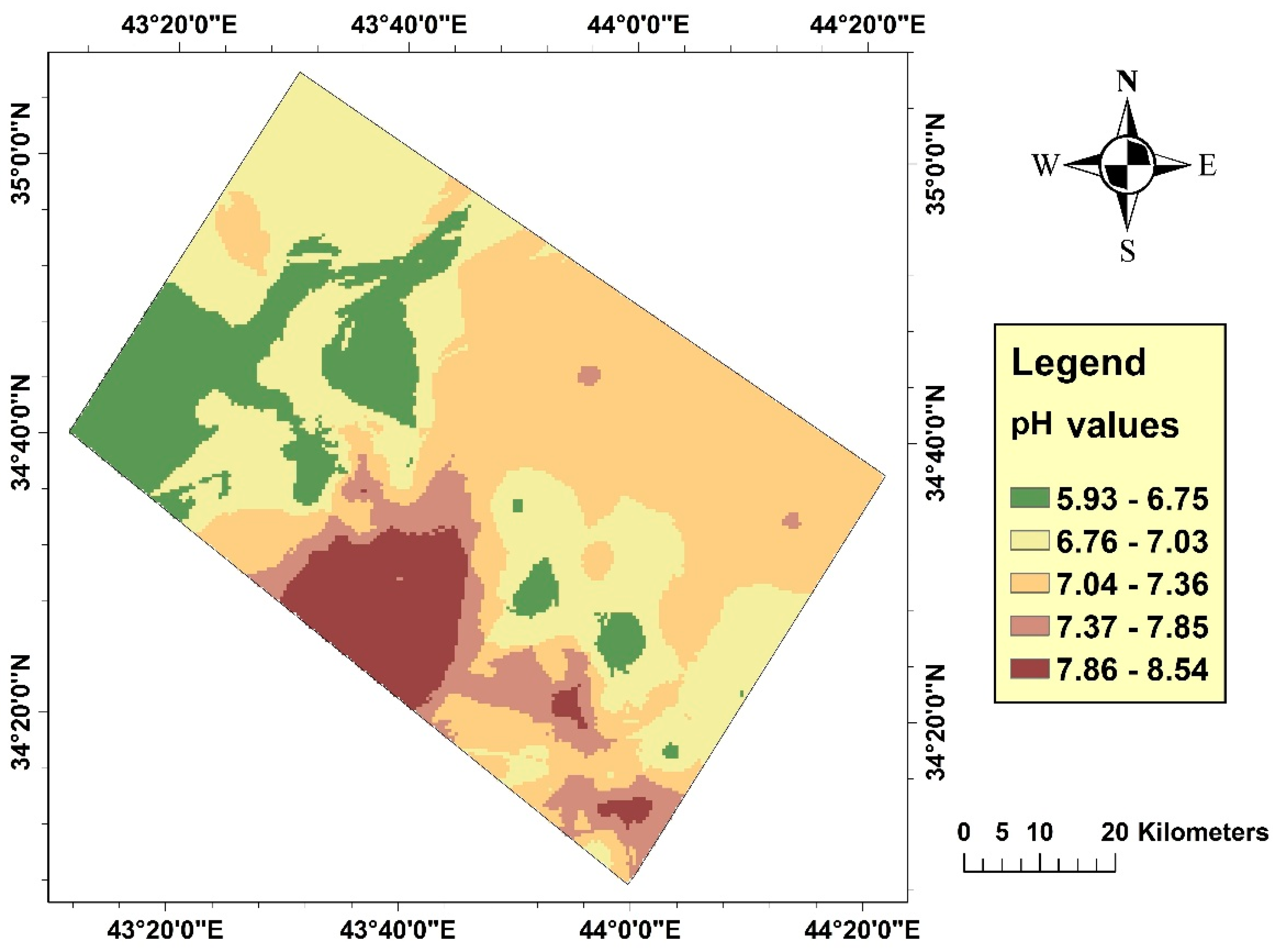
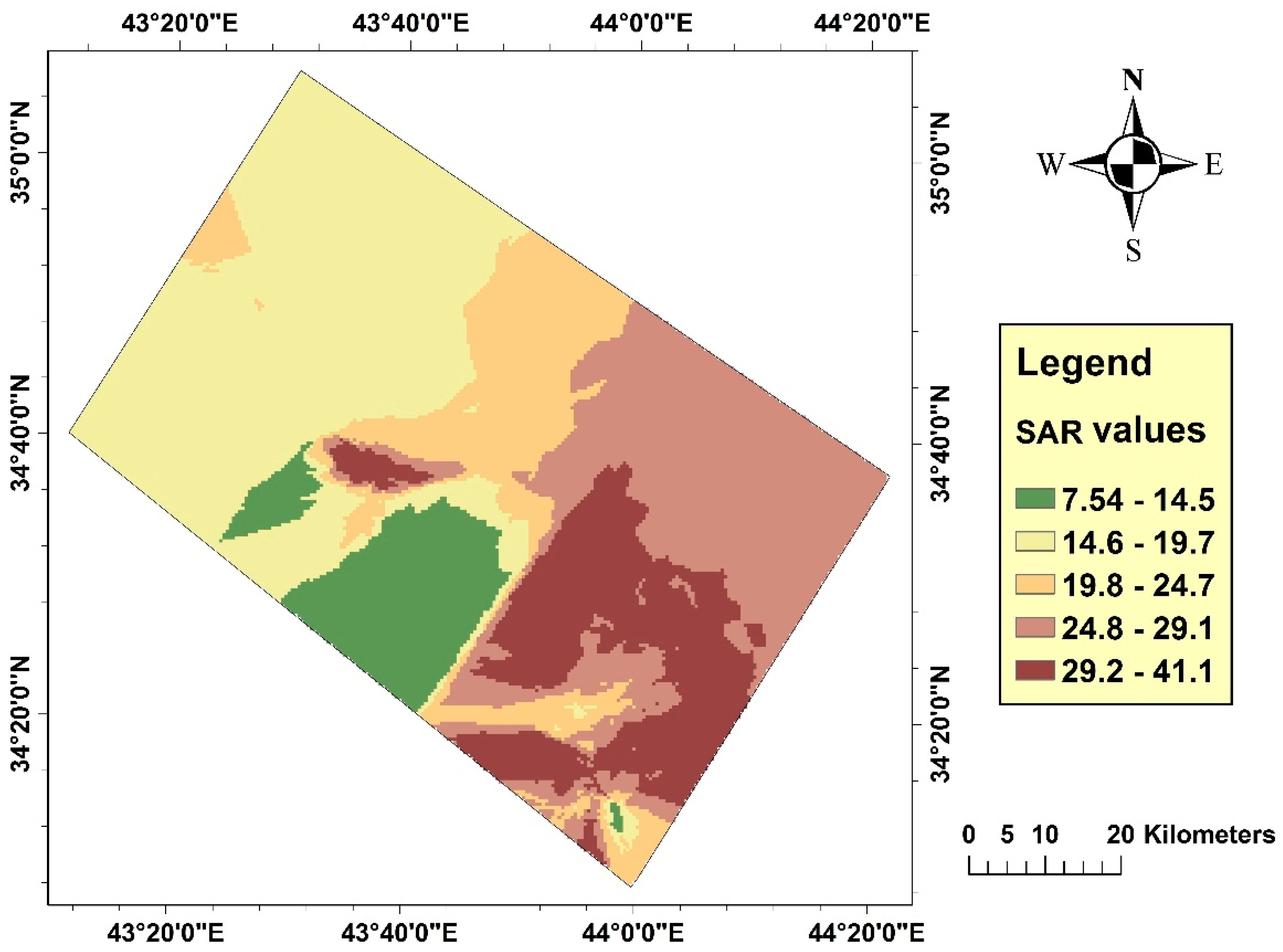
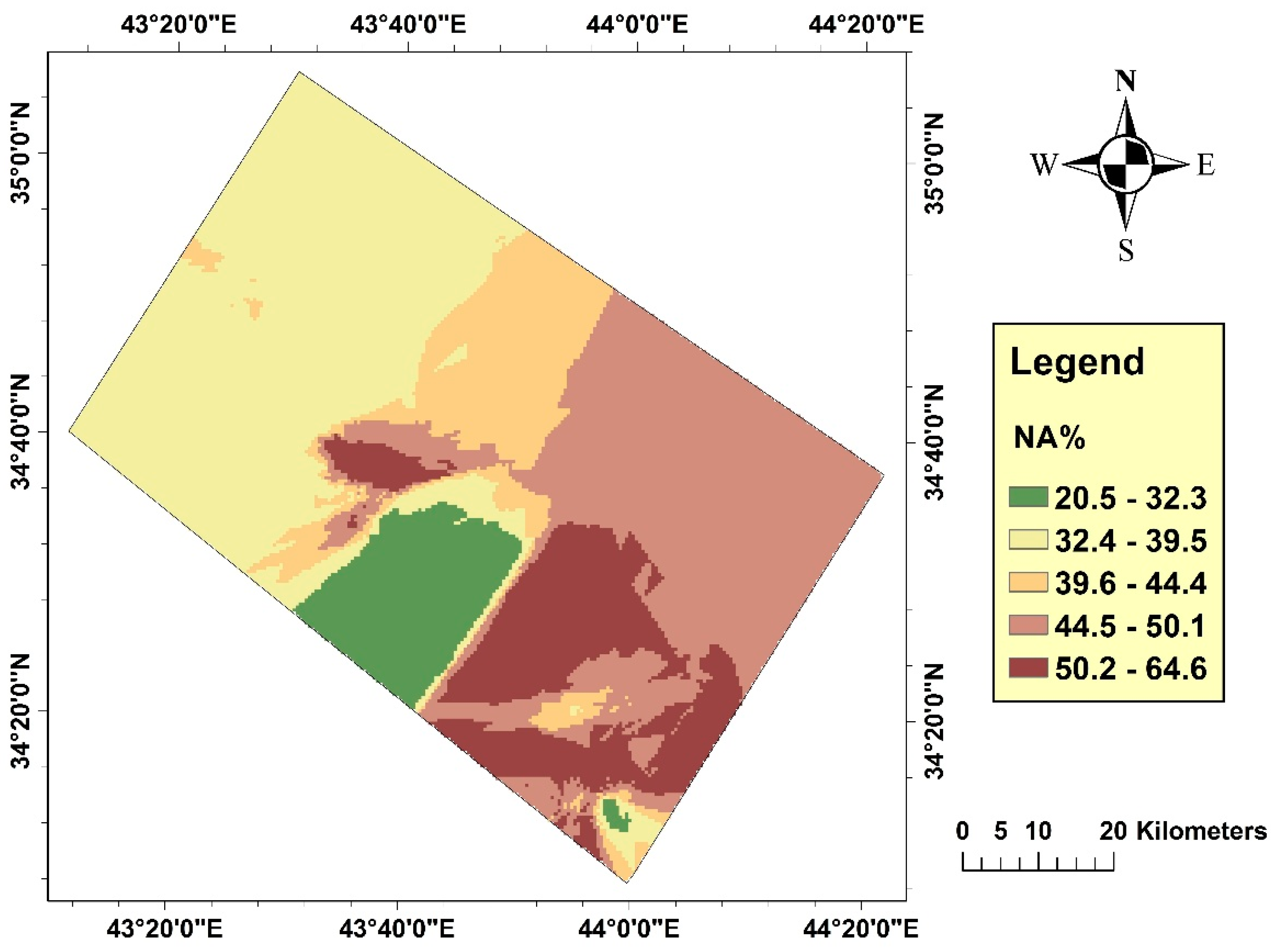
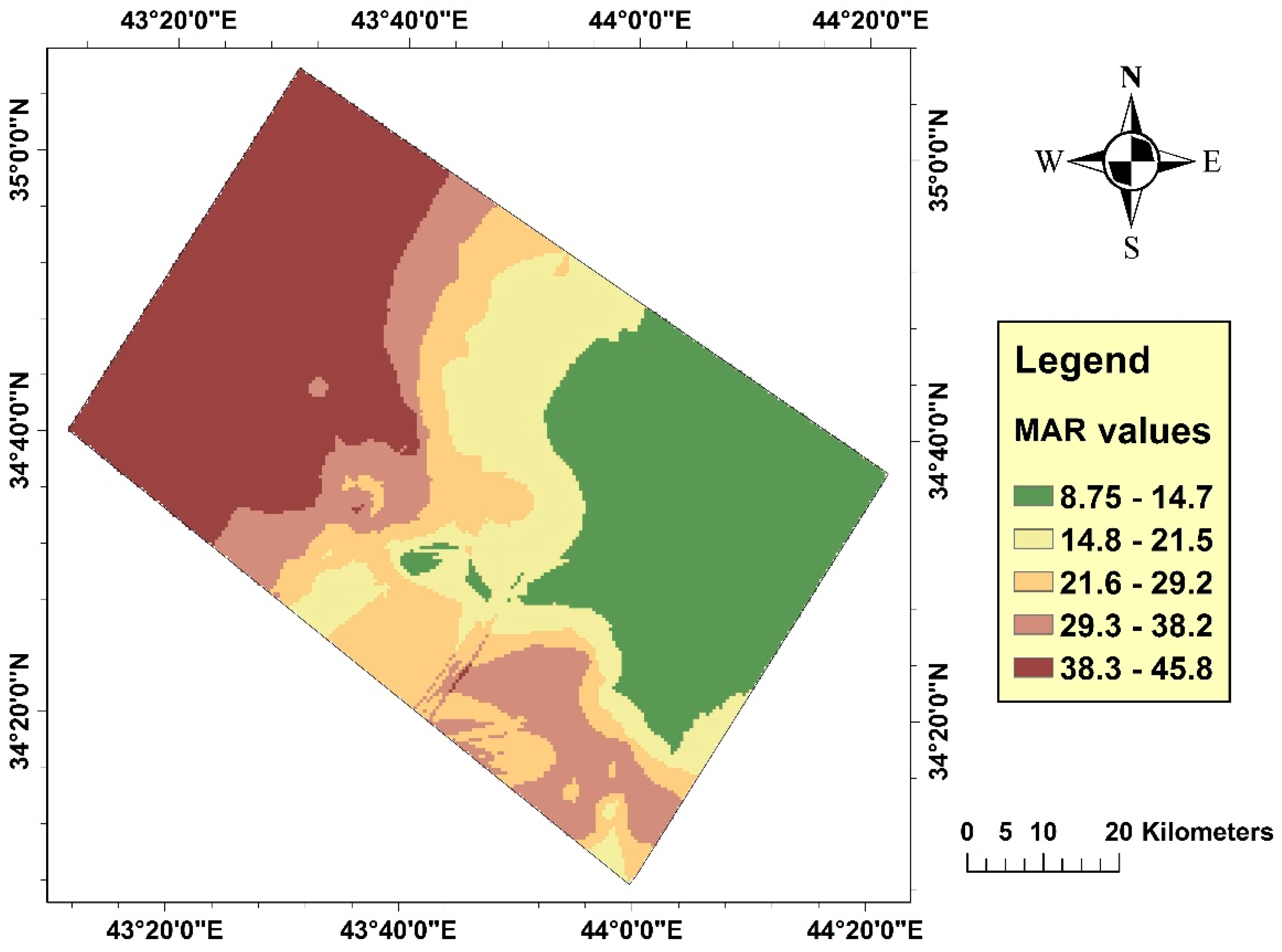
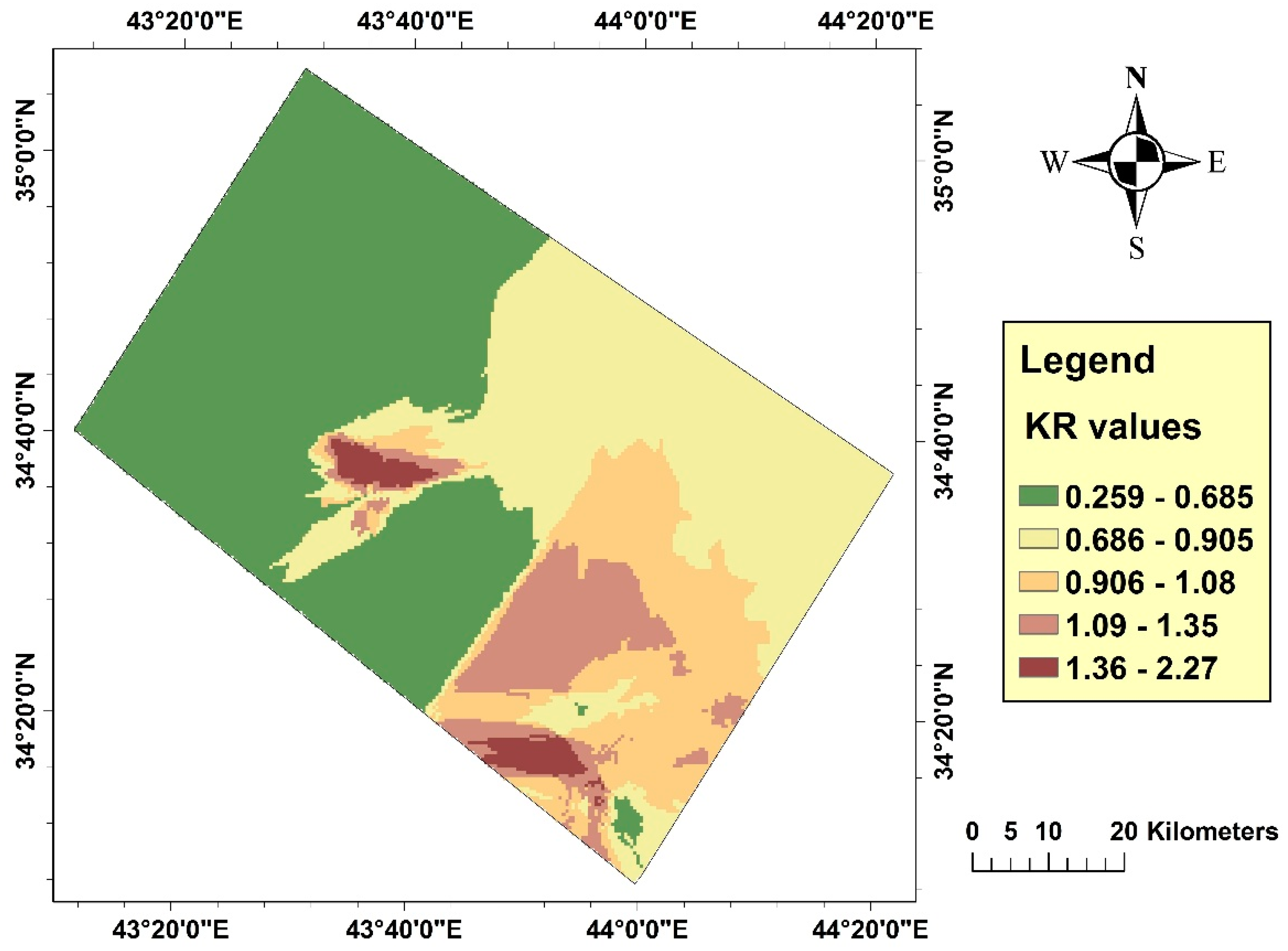
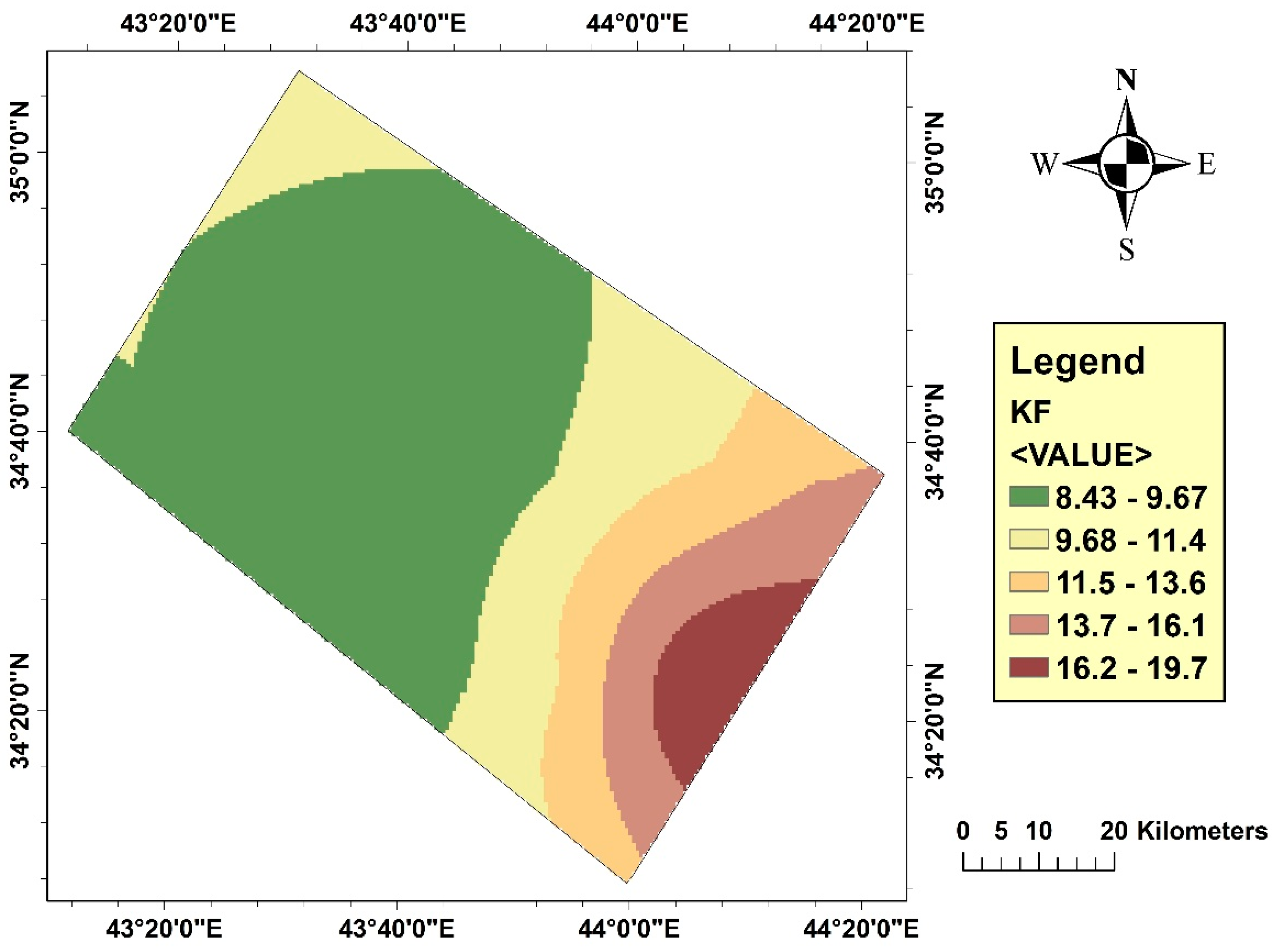
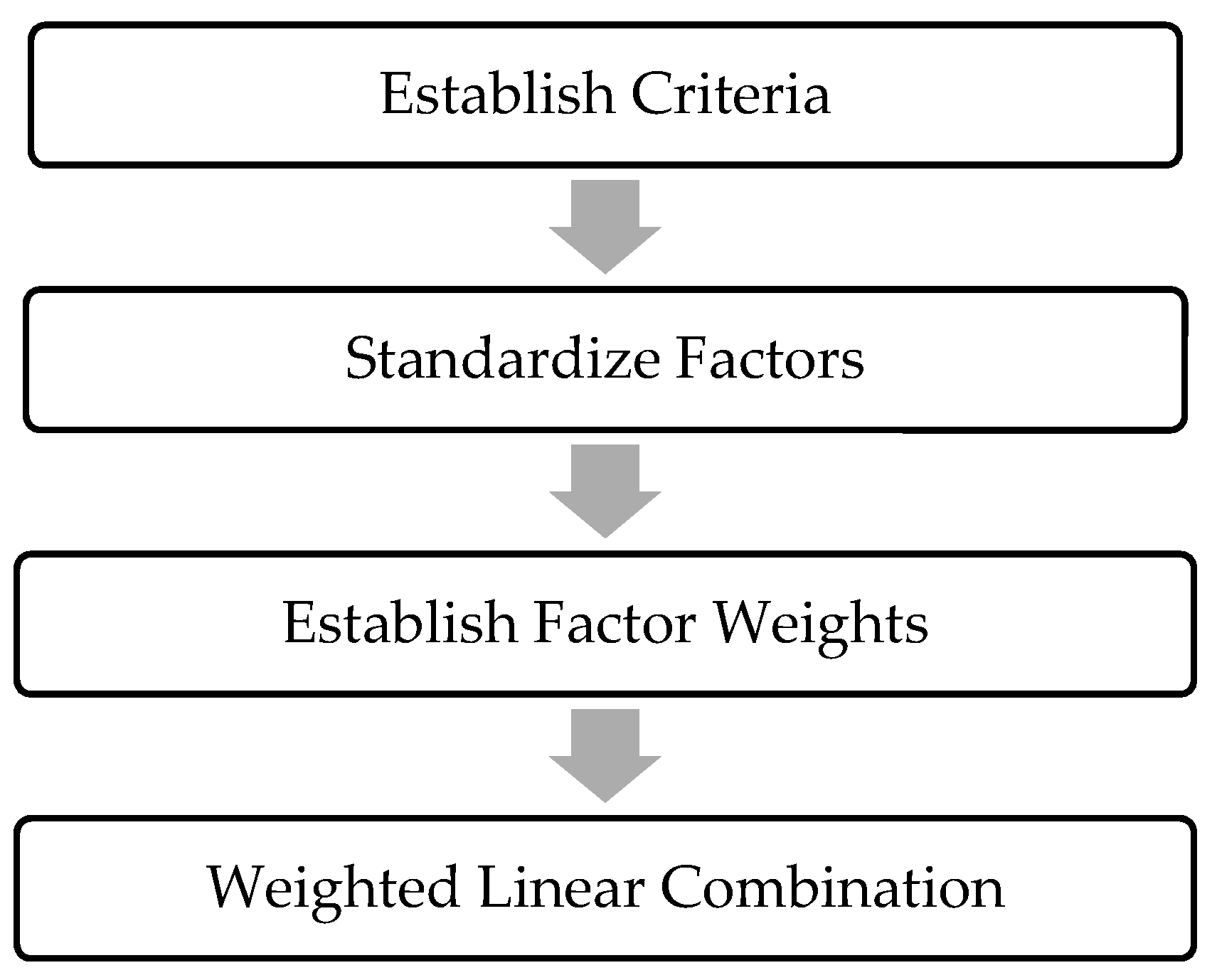
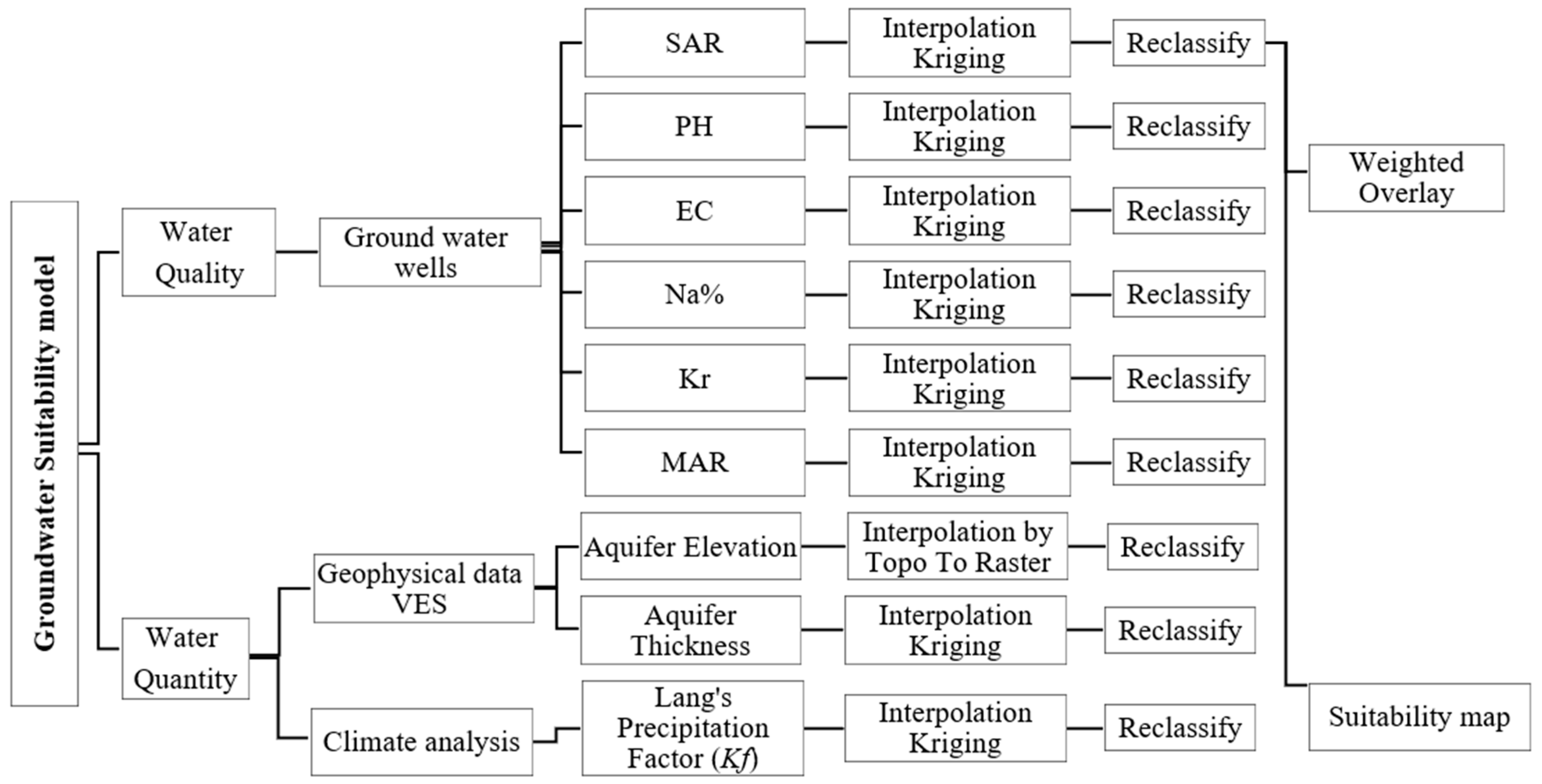
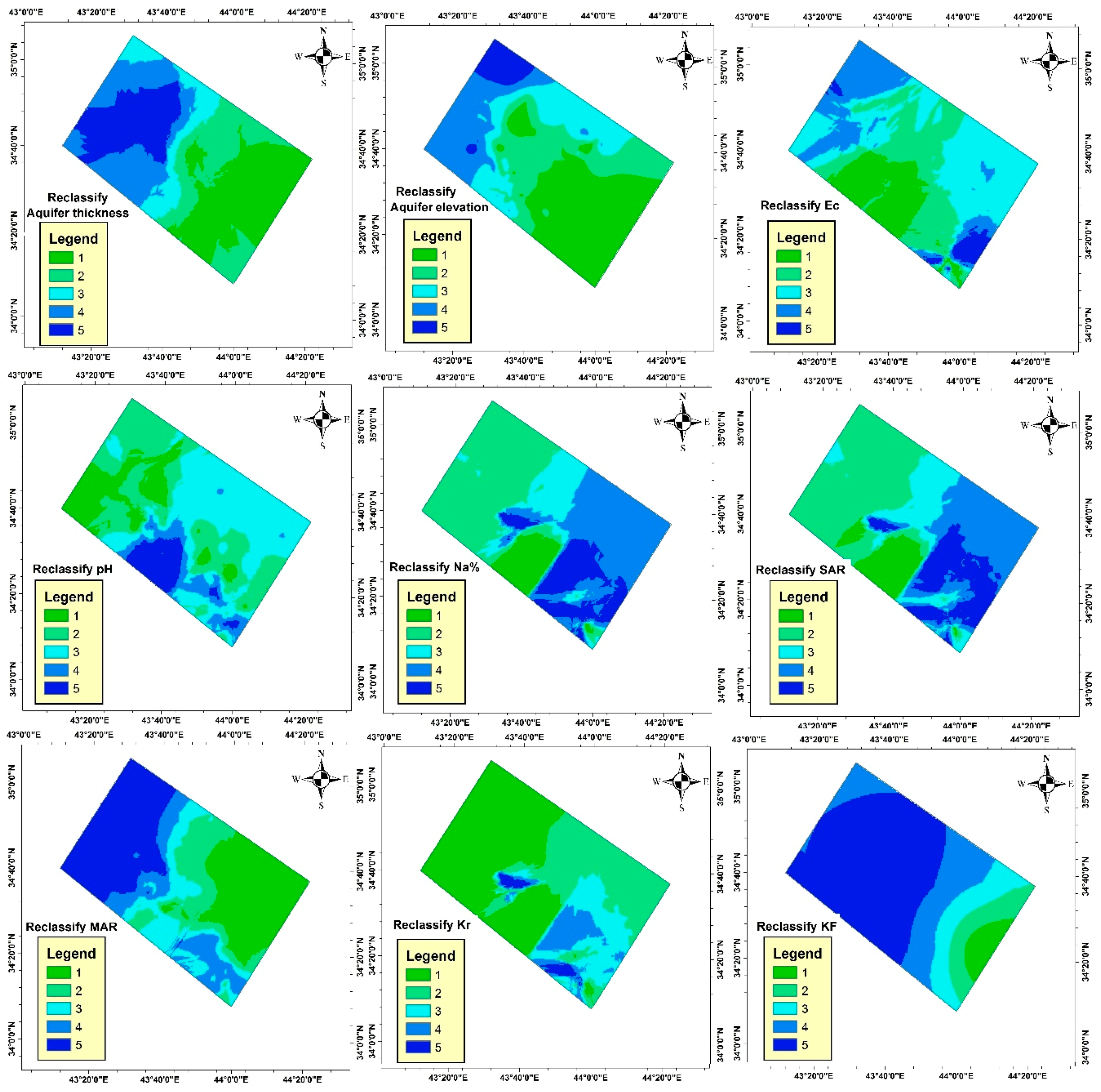
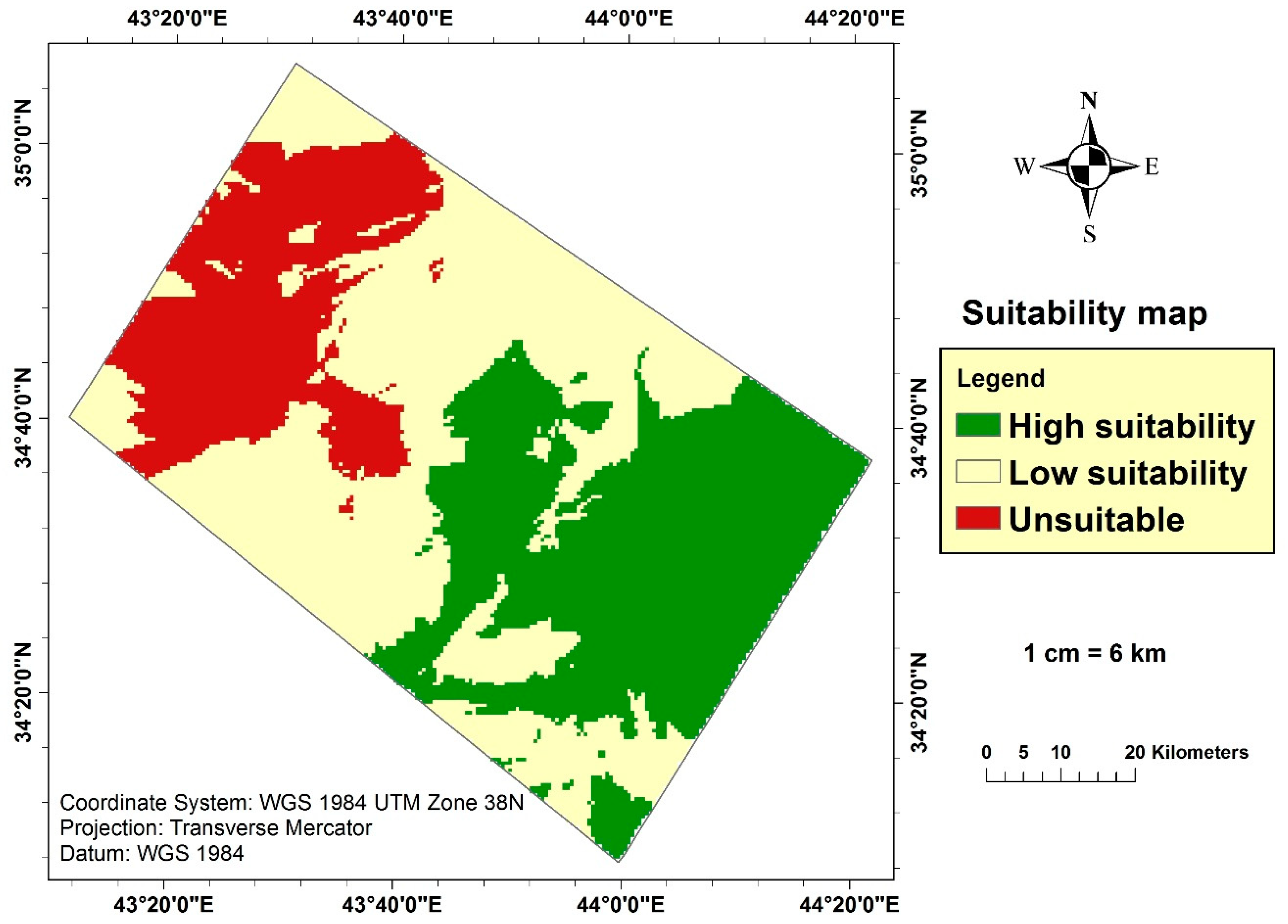
| Classification of Water Salinity | Electrical Conductivity (μs/cm) | Description | Salt Concentration |
|---|---|---|---|
| Low | O < EC < 250 | Used for crops irrigation on most soils. | <0.20 |
| Medium | 250 < EC < 750 | Used in case of moderate amount of leaching occurs. | 0.20–0.50 |
| High | 750 < EC < 2250 | Cannot be used in soil with restricted drainage. | 0.50–1.50 |
| Very high | 2250 < EC ≤ 5000 | Used under special circumstances. The soils must be permeable, irrigation water must be applied in excess to provide considerable leaching, drainage must be adequate, and salt tolerant crops should be selected. | 5–3 |
| SAR Value | Sodium Hazard Classes |
|---|---|
| 0 < SAR < 10 | S1: Low |
| 10 < SAR < 18 | S2: Medium |
| 18 < SAR < 26 | S3: High |
| SAR > 26 | S4: Very High |
| Na% | Water Class |
|---|---|
| Up to 20 | Excellent |
| 20–40 | Good |
| 40–60 | Permissible |
| 60–80 | Doubtful |
| >80 | Unsuitable |
| Kf | Area |
|---|---|
| <60 | Dry, irrigation required |
| 60–70 | Relatively dry |
| 70–80 | Transient |
| 80–100 | Wet |
| >100 | Very wet |
| No. | Thematic Layer | Value | Source | Type | Interpolation Method | Reclassify | Weight |
|---|---|---|---|---|---|---|---|
| 1 | Aquifer Thickness | 66–347 Meter | VES Data | Point | Kriging/Gaussian | 1 = 347 (good) | 30 |
| 5 = 66 (Bad) | |||||||
| 2 | Aquifer Elevation | 53–160 Meter | VES Data | Point | Topo To Raster | 1 = 53 (good) | 10 |
| 5 = 160 (Bad) | |||||||
| 3 | Kf Factor | 8.43–19.7 mm/°C | Satellite-based Precipitation and Temperature | Point | Kriging/Spherical | 1 = 20 (good) | 10 |
| 5 = 8.43 (Bad) | |||||||
| 4 | EC | 2700–5400 μs/cm | Groundwater Wells | Point | Kriging/Spherical | 1 = 2700 (good) | 10 |
| 5 = 5400 (Bad) | |||||||
| 5 | SAR | 7.54–41.1 ppm | Groundwater Wells | Point | Kriging/Exponential | 1 = 7 (good) | 5 |
| 5 = 41 (Bad) | |||||||
| 6 | NA% | 20.5–64.6 ppm | Groundwater Wells | Point | Kriging/Exponential | 1 = 19 (good) | 5 |
| 5 = 65 (Bad) | |||||||
| 7 | MAR | 8.75–45.8 ppm | Groundwater Wells | Point | Kriging/Exponential | 1 = 8 (good) | 10 |
| 5 = 45 (Bad) | |||||||
| 8 | Kr | 0.259–2.27 | Groundwater Wells | Point | Kriging/Exponential | 1 = 0.2 (good) | 10 |
| 5 = 2.2 (Bad) | |||||||
| 9 | pH | 5.93–8.54 | Groundwater Wells | Point | Kriging/Exponential | 1 = 6 (good) | 10 |
| 5 = 8.5 (Bad) |
| Category | Area (km2) | Percentage |
|---|---|---|
| High suitability | 1999.48 | 35.41% |
| Low suitability | 2496.23 | 44.22% |
| Unsuitable | 1150.38 | 20.37% |
| Total Area | 5646.09 km2 | |
© 2019 by the authors. Licensee MDPI, Basel, Switzerland. This article is an open access article distributed under the terms and conditions of the Creative Commons Attribution (CC BY) license (http://creativecommons.org/licenses/by/4.0/).
Share and Cite
Alwan, I.A.; Karim, H.H.; Aziz, N.A. Groundwater Aquifer Suitability for Irrigation Purposes Using Multi-Criteria Decision Approach in Salah Al-Din Governorate/Iraq. AgriEngineering 2019, 1, 303-323. https://doi.org/10.3390/agriengineering1020023
Alwan IA, Karim HH, Aziz NA. Groundwater Aquifer Suitability for Irrigation Purposes Using Multi-Criteria Decision Approach in Salah Al-Din Governorate/Iraq. AgriEngineering. 2019; 1(2):303-323. https://doi.org/10.3390/agriengineering1020023
Chicago/Turabian StyleAlwan, Imzahim A., Hussein H. Karim, and Nadia A. Aziz. 2019. "Groundwater Aquifer Suitability for Irrigation Purposes Using Multi-Criteria Decision Approach in Salah Al-Din Governorate/Iraq" AgriEngineering 1, no. 2: 303-323. https://doi.org/10.3390/agriengineering1020023
APA StyleAlwan, I. A., Karim, H. H., & Aziz, N. A. (2019). Groundwater Aquifer Suitability for Irrigation Purposes Using Multi-Criteria Decision Approach in Salah Al-Din Governorate/Iraq. AgriEngineering, 1(2), 303-323. https://doi.org/10.3390/agriengineering1020023





